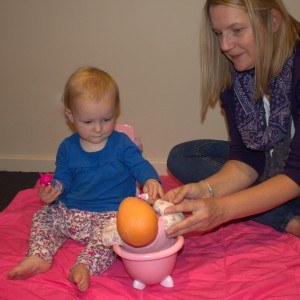 Children have an in-built need to play which begins when they are babies. Play is vital for developing language, thinking, motor skills and social skills. As children grow and develop the type of play they enjoy changes too. Providing the right kinds of play opportunities for your child’s age and stage of development can greatly enhance their learning and skill development.
Children have an in-built need to play which begins when they are babies. Play is vital for developing language, thinking, motor skills and social skills. As children grow and develop the type of play they enjoy changes too. Providing the right kinds of play opportunities for your child’s age and stage of development can greatly enhance their learning and skill development.
Today we are looking at pretend play which begins to develop toddlers. The information provided would also be suitable for older children with delayed development.
Pretend play development in toddlers:
Toddlers begin to pretend by copying the things they see adults do everyday. This means that their earliest play themes will be about daily activities such as eating, dressing and grooming. Young toddlers at around 12 months will being to copy things they see adults do. They will begin with actions that they can do with their own body such as pretending to drink from a cup, eat from a spoon, brush their hair or put a hat on their head.
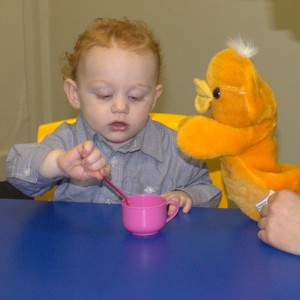 At around 12 months children will do a single action with an object such as putting a spoon in their mouth or a spoon in a bowl.
At around 12 months children will do a single action with an object such as putting a spoon in their mouth or a spoon in a bowl.
As they move towards two years they begin to combine two or three actions in a sequence, such as putting a spoon in a bowl, stirring and then putting the spoon in their mouth.
Younger toddlers will show they know what things are used for. They will pretend to brush their hair with a brush or put a hat on their head.
As they move towards two years children will being to substitute objects for other things. For example they may pretend a box is a bed or block is a car.
As they approach two years children begin to "role play" or act out the things they have seen others do. They may pretend to feed Mum with a spoon or brush Dad's hair copying the things they have seen many times before.
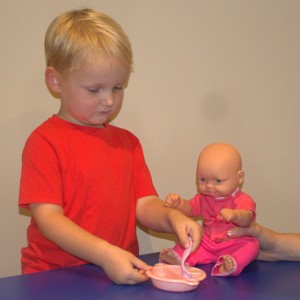 Doll and teddy play begins at this age too. At around one year children know how to hold teddy up the right way, with his head up in a sitting or standing position. Between one and one and a half they begin to do single actions with a doll or teddy such as hugging it. As they approach two years they use teddies or dolls to relate to other objects such as sitting it in a chair or giving it a drink.
Doll and teddy play begins at this age too. At around one year children know how to hold teddy up the right way, with his head up in a sitting or standing position. Between one and one and a half they begin to do single actions with a doll or teddy such as hugging it. As they approach two years they use teddies or dolls to relate to other objects such as sitting it in a chair or giving it a drink.
Choosing toys that encourage pretending and playing with your child can help this important skill to develop.
- Offer your child a choice of toys (not so many they are overwhelmed, just two to three)
- Sit back and watch what catches their interest.
- When they choose a toy show them what to do with it. You may have two things the same or you can take turns. Say "my turn", gently take the toy, show them one quick action, then hand it back "your turn". If this causes a meltdown have two similar toys, such as cups from a tea set.
- If they don;t copy you can give some gentle hand over hand support.
- When they can copy one action, link two actions together. First model the two actions in sequence, then later help your child do the new action and let them do the familiar one themselves. As they link actions continue to add or change the actions slightly to expand their skills.
Toys and activities to develop pretending:
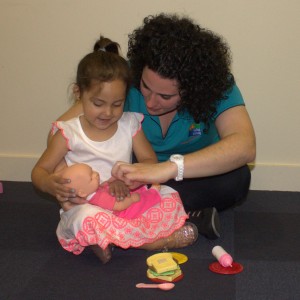 1. Dolls, teddies and soft toys. Most kids have a ton of them but don't leave them to gather dust. Build them into your child's life as "friend" to help your child learn to pretend. Put teddy in your child's chair, swing, bike. Give them a "bath" in a bowl. Only pretend water for teddies, but some dolls cope with water and can go in the bath with your child (some get water inside and can be hard to drain). Put them to bed in a box, with a tea towel for a blanket.
1. Dolls, teddies and soft toys. Most kids have a ton of them but don't leave them to gather dust. Build them into your child's life as "friend" to help your child learn to pretend. Put teddy in your child's chair, swing, bike. Give them a "bath" in a bowl. Only pretend water for teddies, but some dolls cope with water and can go in the bath with your child (some get water inside and can be hard to drain). Put them to bed in a box, with a tea towel for a blanket.
2. Kitchen stuff. My grandmothers idea of toddler play was a cupboard full of old pots and pans, wooden spoons and Tupperware and it's still something kids love today. They can bang and stir and pretend to eat and drink. When they put a bowl or pot on their head they are not getting it wrong, they are beginning to show "object substitution" with a pretend hat. Old kitchen stuff can work well in a sandpit or in water play or in the bath too.
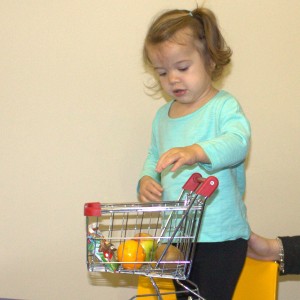 3. Tea sets, cooking sets and pretend food. These toys can be really cheap and as kids develop they can be used in more and more complex ways. Toddlers can begin pretending to eat, drink, feed teddy and move to sequences of feeding, cooking and washing up.
3. Tea sets, cooking sets and pretend food. These toys can be really cheap and as kids develop they can be used in more and more complex ways. Toddlers can begin pretending to eat, drink, feed teddy and move to sequences of feeding, cooking and washing up.
4. Trucks and cars. Bigger trucks and cars are good for toddlers so they can put blocks, dolls or animals in and out. Practice opening the door, sitting down and waving goodbye, driving around the floor then hopping out, saying hello and doing it all again.
5. Things for bath play. You can use real or pretend items for this, such as a brush, comb, cloth, towel or toothbrush. Doll sets with toy beds, prams and potties can be good or you can use boxes and other things from around the house.
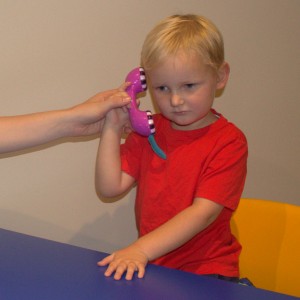 6. Things kids see adults use. This can start simple with keys to pretend to open things and of course phones (old mobile phones can be dangerous so use a pretend plastic one, or use an old landline type phone but cut the cords off). Plastic lawnmowers, tools and pretend appliances can be fun. You can make easily make them from cardboard boxes and other bits and pieces. If you are not creative try Pinterest for inspiration.
6. Things kids see adults use. This can start simple with keys to pretend to open things and of course phones (old mobile phones can be dangerous so use a pretend plastic one, or use an old landline type phone but cut the cords off). Plastic lawnmowers, tools and pretend appliances can be fun. You can make easily make them from cardboard boxes and other bits and pieces. If you are not creative try Pinterest for inspiration.
7. Cubbies. A big box or a blanket over a couple of chairs is fine. Put some cushions inside as a place for teddy to go to sleep or to have a drink and a snack. Cubbies are another toy that can grow with your child, as their play gets more complex.
Toys don't need to be complex or expensive in fact simple toys are often more flexible so kids use them for longer and in more complex ways and the same goes for household items and recycled bits and pieces. So remember when you give your child a box to play with you are not being tight with money you are encouraging your child's creativity.
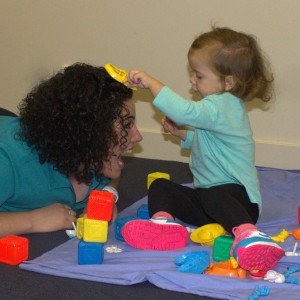 Need support for your child? Talking Matters provides assessment, diagnosis,therapy and support for children with a wide range of needs including developmental delays, learning and literacy challenges, speech and language delays, motor skill and sensory issues and children on the autism spectrum and their families.We are providers under the NDIA. We provide speech pathology, occupational therapy, social skills and play skills groups. We provide services in local schools and our disability consultant can help teachers support children who are experiencing difficulties in school. To find out more about our services and our team visit our website.
Need support for your child? Talking Matters provides assessment, diagnosis,therapy and support for children with a wide range of needs including developmental delays, learning and literacy challenges, speech and language delays, motor skill and sensory issues and children on the autism spectrum and their families.We are providers under the NDIA. We provide speech pathology, occupational therapy, social skills and play skills groups. We provide services in local schools and our disability consultant can help teachers support children who are experiencing difficulties in school. To find out more about our services and our team visit our website.
Our website has a range of downloadable information sheets, printable activities and useful links. To connect with our community of families, therapists and educators join us on Facebook, Twitter and pintrest.
Related Blog Posts
If you liked this post you may also like:
Value of pretending
OT helps kids move!
A Good Night's Sleep
Bubbles, sand and water



